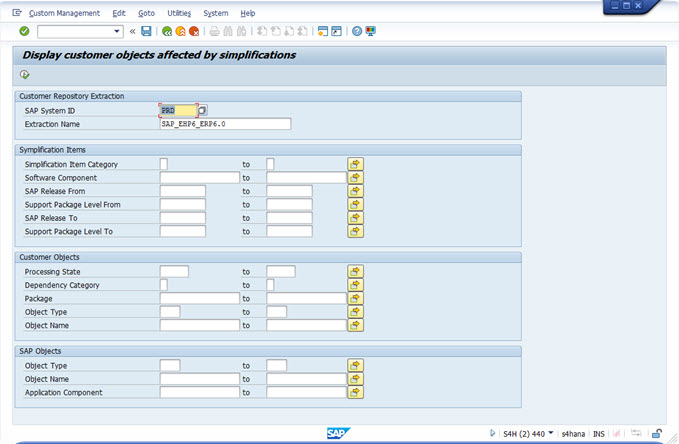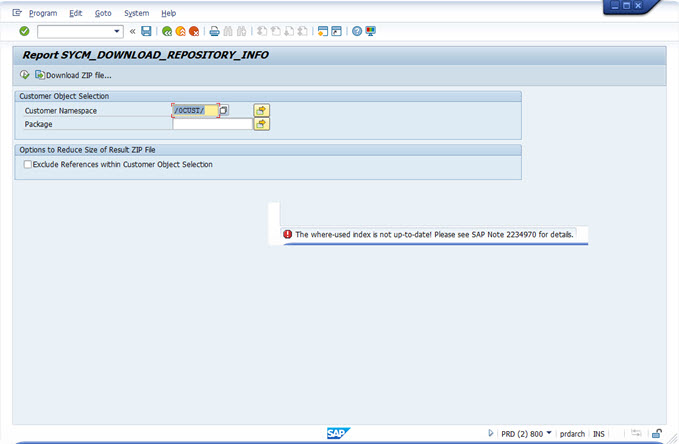
- SAP Community
- Products and Technology
- Enterprise Resource Planning
- ERP Blogs by Members
- S/4HANA System Conversion Pre-check Customer Code ...
- Subscribe to RSS Feed
- Mark as New
- Mark as Read
- Bookmark
- Subscribe
- Printer Friendly Page
- Report Inappropriate Content
Hi everyone, in this blog I'm going to talk about some of the basic configurations of Customer Code Check (or Customer Code Migration) when doing a S/4HANA System Conversion.
Foreword
The following picture shows the procedure and landscape involved in the task.

Basically, you'll need an AS ABAP NetWeaver 7.5 system as shown in the above picture (the evaluation system doesn't have to be a S/4HANA system, any AS ABAP NW 7.5 system will be ok), at first we thought the new Solution Manager 7.2 will do so, but unfortunately Solution Manager 7.2 was build on NetWeaver 7.4.
References
Custom Code Migration Worklist - Application Development on AS ABAP - SAP Library
Using the Custom Code Migration Worklist - Application Development on AS ABAP - SAP Library
2241080 - Custom code check content for SAP S/4HANA on-premise edition
https://launchpad.support.sap.com/#/notes/2241080
How we did it
1. On ERP Source System
1.1 Implement SAP Note 2185390, follow the the Note to perform manual-activities.

1.2 Run report SYCM_DOWNLOAD_REPOSITORY_INFO
Run report SYCM_DOWNLOAD_REPOSITORY_INFO with SE38 (we'll talk about the error "the where-used index is not up-to-date" later on), you may want to run it as a background job if you have a lot of customer developed programs.
Customer Namesapce = /0CUST/

1.3 Download the Customer Repository ZIP file
Wait until the job gets finished, then you should be able to download the ZIP file to your local computer.
2. On the Evaluation System (NW 7.5 System)
2.1 Upload the Customer Repository ZIP file
Upload the Customer Repository zip file into the evaluate system by execute program SYCM_UPLOAD_REPOSITORY_INFO with SE38, give it a extraction name.

2.2 Import the SMB
Download the latest patch of Simplification Database Content from SAP launchpad support one app by doing a quick search CCMSIDB.
Import the downloaded simplification database zip file into evaluate system through report SYCM_UPLOAD_SIMPLIFIC_INFO with SE38.

2.3 Analyze the Impact of the Simplification
Launch the Custom Code Migration Worklist by using transaction SYCM, fill the SAP System ID and Extraction Name and click on execute.

The results will give you a glance of the customer objects affected by the simplifications

You can find more information like SAP Object Name, Application Component, most importantly the Simplification Category and relevant SAP Note

As mentioned in the SAP document, the follow paragraph gives an overview of the Simplification Category
Simplification Category: Represents the category of the simplification item
The following categories are provided:
- Usage of functionality not supported anymore: Usages of this SAP object must be removed from the custom code.
- Usage of functionality not recommended anymore: SAP recommends to remove usages of this SAP object from the custom code.
- Syntactically incompatible change: Custom code needs to be adapted as described in the related SAP Note.
- Semantically incompatible change : Custom code needs to be adapted to the new semantics as described in the related SAP Note.
- Change with performance impact: Usages of this SAP object might have impact on your custom code.
3. Error "the where-used index is not up-to-date" in the ERP Source System

To solve this problem, we can perform the following activities in the ERP system:
1. Run report SAPRSEUJ with SE38
2. Wait until the job EU_INIT gets finished, then run the following reports with SE38 as background job:
SAPRSEUB
SAPRSEUC
For more information about how to solve this problem, please check the following SAP Notes:
2234970 - Job EU_INIT
18023 - Jobs EU_INIT, EU_REORG, EU_PUT
That's all, I hope this will help you and I'm willing to receive your feedback!
Regards,
Michael
- SAP Managed Tags:
- SAP S/4HANA
You must be a registered user to add a comment. If you've already registered, sign in. Otherwise, register and sign in.
-
"mm02"
1 -
A_PurchaseOrderItem additional fields
1 -
ABAP
1 -
ABAP Extensibility
1 -
ACCOSTRATE
1 -
ACDOCP
1 -
Adding your country in SPRO - Project Administration
1 -
Advance Return Management
1 -
AI and RPA in SAP Upgrades
1 -
Approval Workflows
1 -
Ariba
1 -
ARM
1 -
ASN
1 -
Asset Management
1 -
Associations in CDS Views
1 -
auditlog
1 -
Authorization
1 -
Availability date
1 -
Azure Center for SAP Solutions
1 -
AzureSentinel
2 -
Bank
1 -
BAPI_SALESORDER_CREATEFROMDAT2
1 -
BRF+
1 -
BRFPLUS
1 -
Bundled Cloud Services
1 -
business participation
1 -
Business Processes
1 -
CAPM
1 -
Carbon
1 -
Cental Finance
1 -
CFIN
1 -
CFIN Document Splitting
1 -
Cloud ALM
1 -
Cloud Integration
1 -
condition contract management
1 -
Connection - The default connection string cannot be used.
1 -
Custom Table Creation
1 -
Customer Screen in Production Order
1 -
Data Quality Management
1 -
Date required
1 -
Decisions
1 -
desafios4hana
1 -
Developing with SAP Integration Suite
1 -
Direct Outbound Delivery
1 -
DMOVE2S4
1 -
EAM
1 -
EDI
3 -
EDI 850
1 -
EDI 856
1 -
edocument
1 -
EHS Product Structure
1 -
Emergency Access Management
1 -
Energy
1 -
EPC
1 -
Financial Operations
1 -
Find
1 -
FINSSKF
1 -
Fiori
1 -
Flexible Workflow
1 -
Gas
1 -
Gen AI enabled SAP Upgrades
1 -
General
1 -
generate_xlsx_file
1 -
Getting Started
1 -
HomogeneousDMO
1 -
IDOC
2 -
Integration
1 -
Learning Content
2 -
LogicApps
2 -
low touchproject
1 -
Maintenance
1 -
management
1 -
Material creation
1 -
Material Management
1 -
MD04
1 -
MD61
1 -
methodology
1 -
Microsoft
2 -
MicrosoftSentinel
2 -
Migration
1 -
mm purchasing
1 -
MRP
1 -
MS Teams
2 -
MT940
1 -
Newcomer
1 -
Notifications
1 -
Oil
1 -
open connectors
1 -
Order Change Log
1 -
ORDERS
2 -
OSS Note 390635
1 -
outbound delivery
1 -
outsourcing
1 -
PCE
1 -
Permit to Work
1 -
PIR Consumption Mode
1 -
PIR's
1 -
PIRs
1 -
PIRs Consumption
1 -
PIRs Reduction
1 -
Plan Independent Requirement
1 -
Premium Plus
1 -
pricing
1 -
Primavera P6
1 -
Process Excellence
1 -
Process Management
1 -
Process Order Change Log
1 -
Process purchase requisitions
1 -
Product Information
1 -
Production Order Change Log
1 -
purchase order
1 -
Purchase requisition
1 -
Purchasing Lead Time
1 -
Redwood for SAP Job execution Setup
1 -
RISE with SAP
1 -
RisewithSAP
1 -
Rizing
1 -
S4 Cost Center Planning
1 -
S4 HANA
1 -
S4HANA
3 -
Sales and Distribution
1 -
Sales Commission
1 -
sales order
1 -
SAP
2 -
SAP Best Practices
1 -
SAP Build
1 -
SAP Build apps
1 -
SAP Cloud ALM
1 -
SAP Data Quality Management
1 -
SAP Maintenance resource scheduling
2 -
SAP Note 390635
1 -
SAP S4HANA
2 -
SAP S4HANA Cloud private edition
1 -
SAP Upgrade Automation
1 -
SAP WCM
1 -
SAP Work Clearance Management
1 -
Schedule Agreement
1 -
SDM
1 -
security
2 -
Settlement Management
1 -
soar
2 -
Sourcing and Procurement
1 -
SSIS
1 -
SU01
1 -
SUM2.0SP17
1 -
SUMDMO
1 -
Teams
2 -
User Administration
1 -
User Participation
1 -
Utilities
1 -
va01
1 -
vendor
1 -
vl01n
1 -
vl02n
1 -
WCM
1 -
X12 850
1 -
xlsx_file_abap
1 -
YTD|MTD|QTD in CDs views using Date Function
1
- « Previous
- Next »
- Jumpstart your cloud ERP journey with guided enablement in RISE with SAP Methodology in Enterprise Resource Planning Blogs by SAP
- The Role of SAP Business AI in the Chemical Industry. Overview in Enterprise Resource Planning Blogs by SAP
- SAP ERP Functionality for EDI Processing: UoMs Determination for Inbound Orders in Enterprise Resource Planning Blogs by Members
- Merging Customer & Vendor into single BP in Enterprise Resource Planning Q&A
- SAP Enterprise Support Academy Newsletter April 2024 in Enterprise Resource Planning Blogs by SAP
| User | Count |
|---|---|
| 5 | |
| 2 | |
| 2 | |
| 2 | |
| 2 | |
| 2 | |
| 2 | |
| 1 | |
| 1 | |
| 1 |